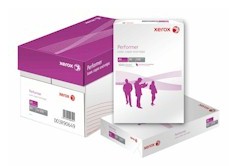 PAPER
PAPER
Modern copiers and MFPs are one of the marvels of the digital age...it may sound silly. Not too long ago, office copy rooms used offset presses. After a day of squeezing tubes of ink onto rollers, we'd all have a greater appreciation for today's advanced machines.
Although office print solutions have evolved, they still share one main ingredient with their predecessors: paper.
That said, there are some basic paper properties that anyone who has ever loaded an empty printer paper tray should learn:
- Curl
- Weight
- Grain
- Calliper
- Moisture content
Why are these things relevant to you? It's simple — understanding these factors is the key to producing high-quality print jobs, with the lowest instance of jamming or malfunction. Read on to get started reducing your printing headaches!
1. Paper Curl
Paper has a tendency to bend in one direction. Just like a long piece of lumber, or a sheet of plywood, printer paper has a natural bow to it called crowning.
Open a ream of paper and cup your fingers loosely under the middle and you will notice the ends sag. Flip it over, do it again and there will be a difference in the amount of sag. Whichever side produces the most sag is the side with the crown is facing up.
If possible, load your paper tray to ensure that printing is done on the crown side. This will, to some extent, counteract the curling produced by printers as the rollers heat and press toner into the paper. Reducing curl is important because paper curl is a major cause of paper jams.
2. Paper Weight
Paper weight is expressed both in grams per square meter (g/m2), and in pounds per 500 sheets of a particular basis size, usually 17” x 22” for copy paper. Thus, a ream of multi-purpose copy paper may be designated at a weight of both 20 lbs and 75 grams. Higher quality paper might be designated 28 lbs and 105 g/m2.
Because different types of paper use different sized basis sheets, the pound system (used only in North America) is not as exact as the metric system in comparing weights of different paper types. For this reason, settings for paper weight on most MFPs is g/m2.
This is an important setting because improperly entering the paper weight can be a factor in paper jamming.
3. Paper Grain
Going against the grain is not just a cliché when it comes to printer paper. Going back to that sheet of plywood, if you ever tried to cut one with a hand saw against the grain you know what I mean. Just like wood, paper always tears straighter with the grain.
Tearing those coupons out of the newspaper is a good way to experience paper grain. And, just like the newspaper, most 8.5”x11” copy paper is long grain in that the grain runs parallel to the long side.
Sometimes, larger sheets of copy paper are short grain. The paper labelling will indicate the grain in that the second dimension figure is the grain direction. Hence, 8.5”x11” is long grain; 11”x17” also means long grain, but 17”x11" is short grain.
Grain awareness in printing is important because colour documents that are folded along the grain will have less toner crack along the fold, resulting in a cleaner, more professional-looking finished product.
4. Paper Calliper
Calliper (thickness) depends on weight and pressing during manufacturing. Thicker paper is generally stiffer and rougher than thin paper. Caliper is expressed in mils (thousandths of an inch) or microns (millionths of a meter).
Calliper is an important paper property because thin paper with low stiffness can wrinkle and then jam a printer. However, thick, stiff paper can also cause jamming because it cannot bend as easily.
5. Moisture Content
A high moisture content and curling go hand in hand. Paper with a moisture content above 5.3% is too wet. Then again, if printer paper is too dry it may cause static electricity, which can lead to jams and misfeeds. Ideal printing paper moisture content is somewhere between 4 and 5 percent. The average UK atmospheric humidity is 25%.
Because moisture content is important, care must be taken in storing printer paper. Moisture proof wrappers help keep paper from absorbing moisture or from drying out in storage. Use opened reams of paper promptly, ift is good policy to get use to opening paper carefully from one end, any un used paper can be put back in its box with the end tucked in to keep it fro absorbing moisture.
Do not take your paper for granted, if you are experiencing jamming problems it is a lot cheaper to buy a ream of good quality paper such as Modo Data Copy, we use Xerox Performer paper as our bench mark paper. If the Printer is still jams with a better quality paper then this is the time to call us to repair the printer.
Always buy a good quality paper, the two mentioned above are good quality papers. Good quality does not necessarily mean expensive, we supply Xerox A4 80gsm paper from £2.13 + vat per ream.
For more information on paper see this guide





 PAPER
PAPER